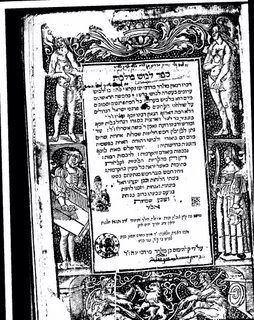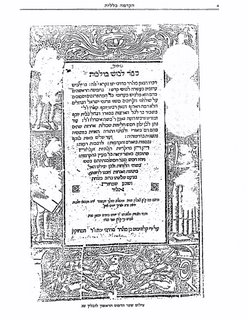Printing was started by non-Jews, however, Jews quickly entered the printing business. However, at times, Jews "borrowed" from non-Jews sources with some interesting repercussions.
Early on many of the Jewish books borrowed title pages from non-Jewish works. This was so, as early title pages utilized woodcuts, which were rather expensive to make. In an effort to cut costs, printers would reuse these woodcuts from other books. Soncino in his early Talmuds as well as in other books used the title page that was used for Aesop's Fables. (See Marvin J. Heller, The Printing of the Talmud, p. 68-70)
In 1697 the Teshuvot haBakh were published for the first time. This first edition actually has two variant editions. The first one was published with a rather elaborate title page that included unclothed women. It appears this edition was immediately pulled and a second title page was substituted. This second page was much simpler with just two cherubs above the text of the title no more nudes. (For more on this topic of altering title pages, see Isaac Rivkind, Sefer Ashir B'Sha'arim, in Studies in Bibliography and Booklore, vol. 1 1953 p. 96-100; A. Freimann, "Ueber Schicksale hebraischer Bucher," in Zeitschrift fur Hebrasche Bibliographie, X (1906) esp. p. 175)
More recently, R. Mordechai Yaffo's Levush was republished. This reprint, aside from resetting the type, adding the Eliyaha Rabba and Zuta, and adding additional notes also includes an extensive introduction. This introduction traces the history of the various editions of the Levush as well as explaining its overall value. When it traces the printing history, it includes reproduces the title page of the first edition (Lublin 1589). However, this title pages has strategic white outs. In the first edition on the title page it includes female nudes, these are now whited out.
The inclusion of nudes was not that uncommon. I have seen other seforim that include such depictions either on the title page or at times even in the text. One notable example is a Mahzor published in Venice in 1710. This edition includes a depiction of semi-nude women right before the start of Barukh She'amar. From an artistic perspective this arguably adds to the book, however, from a religious perspective one must assume that it may offend some. However, there is no explanation for this picture so we are left to wonder what was the motive of the publishers.
Early on many of the Jewish books borrowed title pages from non-Jewish works. This was so, as early title pages utilized woodcuts, which were rather expensive to make. In an effort to cut costs, printers would reuse these woodcuts from other books. Soncino in his early Talmuds as well as in other books used the title page that was used for Aesop's Fables. (See Marvin J. Heller, The Printing of the Talmud, p. 68-70)
In 1697 the Teshuvot haBakh were published for the first time. This first edition actually has two variant editions. The first one was published with a rather elaborate title page that included unclothed women. It appears this edition was immediately pulled and a second title page was substituted. This second page was much simpler with just two cherubs above the text of the title no more nudes. (For more on this topic of altering title pages, see Isaac Rivkind, Sefer Ashir B'Sha'arim, in Studies in Bibliography and Booklore, vol. 1 1953 p. 96-100; A. Freimann, "Ueber Schicksale hebraischer Bucher," in Zeitschrift fur Hebrasche Bibliographie, X (1906) esp. p. 175)
More recently, R. Mordechai Yaffo's Levush was republished. This reprint, aside from resetting the type, adding the Eliyaha Rabba and Zuta, and adding additional notes also includes an extensive introduction. This introduction traces the history of the various editions of the Levush as well as explaining its overall value. When it traces the printing history, it includes reproduces the title page of the first edition (Lublin 1589). However, this title pages has strategic white outs. In the first edition on the title page it includes female nudes, these are now whited out.
The inclusion of nudes was not that uncommon. I have seen other seforim that include such depictions either on the title page or at times even in the text. One notable example is a Mahzor published in Venice in 1710. This edition includes a depiction of semi-nude women right before the start of Barukh She'amar. From an artistic perspective this arguably adds to the book, however, from a religious perspective one must assume that it may offend some. However, there is no explanation for this picture so we are left to wonder what was the motive of the publishers.


